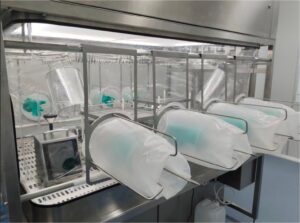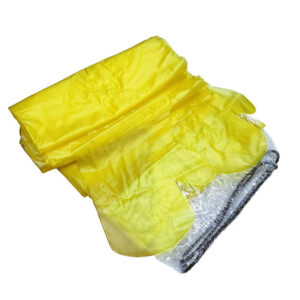Temiz oda işletmecileri, katı hava kalitesi standartlarını korurken işletme giderlerini optimize etme konusunda artan bir baskıyla karşı karşıya kaldıklarında hava fi̇ltresi̇ mali̇yet anali̇zi̇ bunaltıcı hale gelir. Birçok tesis gizli maliyetler, öngörülemeyen değiştirme programları ve orantılı performans kazanımları sağlamadan bütçeleri tüketen verimsiz filtre seçimi ile mücadele etmektedir.
Doğru maliyet analizi yapılmadığında, temiz oda operasyonları genellikle gerekenden 30-40% daha yüksek filtreleme giderleri yaşarken, maliyetli uyumluluk ihlallerini tetikleyebilecek hava kalitesi standartlarından ödün verir. Bu finansal verimsizlikler zaman içinde birleşerek, çok yıllı operasyonel döngüler boyunca gereksiz harcamalarda potansiyel olarak yüz binlerce dolara ulaşır.
Bu kapsamlı kılavuz, gerçek filtreleme maliyetlerinin hesaplanması, filtre teknolojilerinin karşılaştırılması ve hem performansı hem de bütçe tahsisini optimize eden veri odaklı yatırım getirisi stratejilerinin uygulanması için sistematik metodolojiler sunmaktadır. Temiz oda filtre analizi için kanıtlanmış çerçeveleri, maliyet karşılaştırma araçlarını ve hava kalitesi performansını artırırken 25-35% maliyet düşüşleri elde etmek için endüstri liderleri tarafından kullanılan stratejik planlama yaklaşımlarını keşfedeceksiniz.
YOUTH Temiz Teknoloji gelişmiş filtre teknolojileri ve kapsamlı maliyet analizi desteği ile dünya çapındaki tesislerin hava kalitesi yatırımlarını optimize etmelerine yardımcı olarak temiz oda filtrasyon inovasyonunun ön saflarında yer almaktadır.
Hava Filtresi Maliyet Analizinin Temel Bileşenleri Nelerdir?
Temiz oda filtrasyon sistemlerinin tam maliyet yapısını anlamak, ilk satın alma fiyatlarının çok ötesine uzanan, birbirine bağlı çok sayıda değişkeni incelemeyi gerektirir. Etkili temi̇z oda fi̇ltrasyon bütçe planlamasi doğrudan maliyetleri, dolaylı giderleri ve uzun vadeli operasyonel etkileri hesaba katmalıdır.
İlk Yatırım Maliyetleri
Ön yatırım, filtre ünitelerini, kurulum donanımını ve sistem entegrasyon giderlerini kapsar. Yüksek verimli partikül hava (HEPA) filtreleri, boyut ve verimlilik derecelerine bağlı olarak tipik olarak birim başına $150-$800 arasında değişirken, ultra düşük nüfuzlu hava (ULPA) filtreleri birim başına $300-$1,200'dür. Ancak bu temel maliyetler, toplam sahip olma giderlerinin yalnızca 40-60%'sini temsil etmektedir.
Kurulum karmaşıklığı başlangıç maliyetlerini önemli ölçüde etkiler; özel montaj sistemleri, kanal sistemi değişiklikleri ve devreye alma prosedürleri temel filtre fiyatlarına 20-35% ekler. Standart olmayan boyutlar veya özel conta malzemeleri gerektiren özel uygulamalar, standart yapılandırmalara kıyasla maliyetleri 50-100% artırabilir.
İşletme ve Bakım Giderleri
Devam eden işletme maliyetleri arasında enerji tüketimi, değiştirme programları ve işçilik gereksinimleri yer alır. Yüksek verimli filtreler, 0,5-2,0 inç su sütunu arasında değişen basınç düşüşleri yaratarak fan enerji tüketimini doğrudan etkiler. Tipik olarak 1.000 CFM tüketen bir temiz oda, yerel elektrik oranlarına ve sistem verimliliğine göre değişmekle birlikte, filtre konumu başına yıllık $200-$600 enerji maliyetiyle karşılaşır.
| Maliyet Kategorisi | Yıllık Etki | Toplamın Yüzdesi |
|---|---|---|
| Enerji Tüketimi | $200-$600 | 25-35% |
| Yedek Malzemeler | $300-$1,500 | 40-55% |
| İşçilik ve Arıza Süresi | $100-$400 | 15-25% |
| Uyumluluk Testi | $50-$200 | 5-10% |
Bakım işçiliği maliyetleri, erişilebilirlik ve değiştirme karmaşıklığına bağlı olarak önemli ölçüde değişir. Tavana monte edilen sistemler tipik olarak filtre değişimi başına 15-30 dakika gerektirirken, duvara monte edilen ünitelerin bakımı 5-10 dakika içinde yapılabilir ve bu da işçilik giderlerini doğrudan etkiler.
Gizli Maliyet Faktörleri
Deneyimlerimize göre, en çok göz ardı edilen giderler arasında bertaraf ücretleri, envanter taşıma maliyetleri ve arıza süresi etkileri yer almaktadır. Kirlenmiş filtre bertarafı, düzenlemeye tabi sektörlerde birim başına $25-$75'e mal olabilirken, yeterli envanter seviyelerini korumak, işletme sermayesinde filtre pozisyonu başına $500-$2.000'i bağlar.
Filtre değişimleri sırasında üretimin durma süresi, belki de en önemli gizli maliyeti temsil etmektedir. Günlük $50.000 gelir elde eden bir farmasötik temiz oda, filtre değişikliklerinin uzun süreli duruşlar gerektirmesi durumunda önemli kayıplarla karşı karşıya kalır ve bu da hızlı değiştirilen filtre tasarımlarını daha yüksek başlangıç maliyetlerine rağmen ekonomik olarak cazip hale getirir.
Temiz Oda Filtre Yatırımları için ROI Nasıl Hesaplanır?
Doğru geliştirme temiz oda filtresi ROI hesaplayıcısı metodolojileri, toplam sahip olma maliyetine karşı performans faydalarının sistematik olarak değerlendirilmesini gerektirir. Başarılı ROI hesaplamaları hem somut maliyet tasarruflarını hem de azalan kontaminasyon riskleri gibi soyut faydaları ölçmelidir.
ROI Hesaplama Çerçevesi
Temiz oda filtreleri için temel ROI formülü, yıllık maliyet tasarruflarını artan yatırım maliyetleriyle karşılaştırır:
ROI = (Yıllık Tasarruflar - Yıllık Maliyetler) / Toplam Yatırım × 100
Yıllık tasarruflar, enerji verimliliği iyileştirmelerini, uzatılmış değiştirme aralıklarını, azaltılmış bakım işçiliğini ve önlenen kontaminasyon olaylarını kapsar. Standart $300 alternatifine kıyasla $500 maliyetli birinci sınıf bir filtre, yatırımı haklı çıkarmak için yıllık $200+ fayda sağlamalıdır.
Performans Faydalarının Ölçülmesi
Enerji tasarrufu hesaplamaları hassas basınç düşüşü ölçümleri ve fan eğrisi analizi gerektirir. Basınç düşüşünü 0,3 inç su sütunu kadar azaltan bir filtre tipik olarak 1.000 CFM hava akışı başına enerji maliyetlerinde yıllık $150-$300 tasarruf sağlar. Bu tasarruflar çok yıllı servis aralıklarında birleşerek önemli kümülatif faydalar yaratır.
Uzatılmış hizmet ömrü, azaltılmış değiştirme sıklığı sayesinde doğrudan maliyet avantajı sağlar. Standart 12 aylık aralıklara kıyasla 18 ay dayanan premium filtreler malzeme maliyetlerini 33% azaltırken, yılda 2-3 değiştirme prosedürünü ortadan kaldırarak işçilik giderlerinde $100-$200 tasarruf sağlar.
Risk Azaltma Değeri
Gelişmiş filtrasyon sistemleri, maliyetli üretim duruşlarını veya mevzuat ihlallerini tetikleyebilecek kontaminasyon risklerini azaltır. İlaç üretiminde tek bir kontaminasyon olayı üretim kaybında $500.000-$2.000.000'a mal olabilir, bu da üstün filtrelemeyi sadece operasyonel gider yerine bir sigorta yatırımı haline getirir.
Kalite risk değerlendirmeleri, farklı filtreleme senaryoları altında kontaminasyon olaylarının olasılığını ve maliyetini ölçmelidir. Eğer premium filtreleme kontaminasyon olasılığını yıllık 2%'den 0,5%'ye düşürürse, risk azaltma değeri 1,5% potansiyel kontaminasyon maliyetine eşittir.
HEPA Filtre Maliyet Değişimlerini Hangi Faktörler Etkiliyor?
HEPA filtre maliyet karşılaştırması verimlilik dereceleri, yapı malzemeleri ve uygulamaya özel gerekliliklerden kaynaklanan önemli fiyat farklılıklarını ortaya koymaktadır. Bu maliyet etkenlerinin anlaşılması, performans gereksinimleri ile bütçe kısıtlamalarını dengeleyen bilinçli satın alma kararları alınmasını sağlar.
Verimlilik Derecesi Etkisi
HEPA filtreler 0,3 mikronda 99,97% verimlilik (H13 sınıfı) ile 99,999% verimlilik (H14 sınıfı) arasında değişir ve daha yüksek değerler için 25-40% fiyat primleri vardır. 99,9995% verimliliğe ulaşan ULPA filtreler, standart HEPA ünitelerine göre 50-100% primlere sahiptir ve özellikle kontaminasyon risklerinin aşırı olduğu yarı iletken ve farmasötik uygulamalarda haklı çıkar.
Verimlilik ve maliyet arasındaki ilişki üstel bir eğri izler ve her bir ek verimlilik "dokuzu" orantısız maliyetler ekler. 99,99% verimli bir filtre $400'e mal olabilirken, 99,999% birim $600-$700'e mal olur, bu da 0,009% verimlilik artışı için 50-75% prim anlamına gelir.
Yapı ve Malzeme Değişkenleri
Filtre medyası bileşimi fiyatlandırmayı önemli ölçüde etkiler ve sentetik medyanın maliyeti geleneksel cam elyaf alternatiflerine göre 20-30% daha fazladır. Sentetik medya üstün nem direnci ve daha düşük partikül dökülmesi sunarak daha yüksek başlangıç maliyetlerine rağmen kritik uygulamalarda premium fiyatlandırmayı haklı çıkarır.
Çerçeve malzemeleri standart galvanizli çelik konstrüksiyon üzerine alüminyumdan ($50-$100 premium) paslanmaz çeliğe ($100-$200 premium) kadar değişir. İlaç ve gıda işleme uygulamaları genellikle sıhhi uyumluluk için paslanmaz çelik gerektirir, bu da malzeme yükseltmelerini isteğe bağlı olmaktan ziyade zorunlu hale getirir.
Uygulamaya Özel Gereksinimler
Özel boyutlandırma, özel contalar ve benzersiz montaj konfigürasyonları standart filtre maliyetlerine 30-100% ekler. Bununla birlikte, bu modifikasyonlar genellikle gelişmiş sızdırmazlık, daha kolay bakım veya gelişmiş performans özellikleri yoluyla premium fiyatlandırmayı haklı çıkaran operasyonel faydalar sağlar.
200°C+ sıcaklıklara dayanabilen medya gerektiren yüksek sıcaklık uygulamaları, 70°C çalışma için derecelendirilmiş standart filtrelere kıyasla 200-300% primleri gerektirir. Benzer şekilde, nemli ortamlar için neme dayanıklı tasarımlar temel maliyetlere 25-50% ekler ancak zorlu koşullarda erken arızalanmayı önler.
Etkili Bir Hava Filtresi Fiyatlandırma Kılavuzu Nasıl Geliştirilir?
Kapsamlı bir şekilde hava fi̇ltresi̇ fi̇yatlandirma kilavuzu stratejileri pazar araştırması, performans kıyaslaması ve yaşam döngüsü maliyet modellemesi gerektirir. Etkili fiyatlandırma kılavuzları, rekabetçi konumlandırmayı korurken bölgesel farklılıkları, uygulama gereksinimlerini ve tedarikçi yeteneklerini hesaba katmalıdır.
Pazar Araştırması ve Kıyaslama
Sektör araştırmaları, temiz oda filtre fiyatlandırmasının eşdeğer özellikler için tedarikçiler arasında 40-60% arasında değiştiğini göstermekte ve kapsamlı pazar analizinin önemini vurgulamaktadır. Premium üreticiler genellikle emtia tedarikçilerinden 20-30% daha fazla ücret alır, ancak genellikle üstün teknik destek ve ürün tutarlılığı sağlar.
Bölgesel fiyatlandırma farklılıkları yerel üretim maliyetlerini, dağıtım ağlarını ve pazar rekabetini yansıtır. Asyalı üreticiler genellikle Avrupalı veya Amerikalı tedarikçilere göre 25-35% daha düşük fiyatlar sunar, ancak nakliye maliyetleri, teslim süreleri ve kalite farklılıkları toplam maliyet hesaplamalarında dikkate alınmalıdır.
Performansa Dayalı Fiyatlandırma Modelleri
Değer bazlı fiyatlandırma, filtre maliyetlerini verimlilik, basınç düşüşü ve hizmet ömrü gibi performans ölçütleriyle ilişkilendirir. 20% daha uzun hizmet ömrü sağlayan bir filtre orantılı fiyat primlerini haklı çıkarırken, üstün verimlilik dereceleri enerji tasarrufu hesaplamalarına dayalı primleri yönetir.
Performans garantileri ve uzatılmış garantiler, premium fiyatlandırmayı haklı çıkaran bir değer katar. Standart 12 aylık garantilere karşılık 18 aylık hizmet ömrü garantileri sunan tedarikçiler, birçok tesisin ilk maliyet tasarruflarından daha fazla değer verdiği risk azaltma sağlar.
Tedarikçi Değerlendirme Kriterleri
Teknik destek yetenekleri, envanter yönetimi ve acil müdahale hizmetleri, premium tedarikçileri emtia tedarikçilerinden ayırır. 7/24 teknik destek ve garantili teslimat süreleri sunan tedarikçiler, kritik uygulamalarda 10-15% fiyat primlerini haklı çıkaran operasyonel faydalar sağlar.
| Tedarikçi Faktörü | Ağırlık | Prim Gerekçesi |
|---|---|---|
| Ürün Kalitesi | 35% | Kanıtlanmış performans için 20-30% |
| Teknik Destek | 25% | Kapsamlı servis için 10-15% |
| Teslimat Güvenilirliği | 20% | Garantili kullanılabilirlik için 5-10% |
| Garanti Kapsamı | 20% | Genişletilmiş koruma için 15-25% |
Uzun vadeli ortaklık avantajları arasında tercihli fiyatlandırma, ürün geliştirme işbirliği ve envanter yönetimi desteği yer alır. Stratejik tedarikçi ilişkileri kurmak genellikle hacim taahhütleri ve operasyonel verimlilikler yoluyla yıllık 5-10% maliyet düşüşü sağlar.
Filtre Değiştirme Maliyet Analizi için En İyi Uygulamalar Nelerdir?
Sistematik uygulama fi̇ltre deği̇şti̇rme mali̇yet anali̇zi̇ metodolojileri, kestirimci bakım planlaması ve optimize edilmiş envanter yönetimi sağlar. Etkili değiştirme stratejileri, toplam sahip olma maliyetlerini en aza indirmek için hizmet ömrünü uzatma ile performans bakımını dengeler.
Kestirimci Bakım Stratejileri
Basınç farkı izleme, gerçek zamanlı filtre durumu değerlendirmesi sağlayarak zamana dayalı aralıklara kıyasla hizmet ömrünü 20-30% uzatan duruma dayalı değiştirme programlarına olanak tanır. Dijital manometrelerin kurulumu, izleme noktası başına $200-$500'e mal olur, ancak optimize edilmiş değiştirme zamanlaması sayesinde tipik olarak yılda $1,000-$3,000 tasarruf sağlar.
Partikül sayımı ve hava kalitesi izleme, filtre bozulmasını tamamen arızalanmadan önce tespit eder, hizmet ömrünü en üst düzeye çıkarırken kontaminasyon olaylarını önler. Gelişmiş izleme sistemleri $5,000-$15,000'e mal olur ancak önlenen kontaminasyon riskleri ve uzatılmış filtre ömrü sayesinde yatırımı haklı çıkarır.
Envanter Optimizasyonu
Tam zamanında envanter yönetimi, filtre kullanılabilirliğini sağlarken taşıma maliyetlerini azaltır. Optimum envanter seviyeleri tipik olarak ortalama değiştirme aralıklarının 1,5-2,0 katına eşittir ve kullanılabilirliği işletme sermayesi verimliliği ile dengeler.
Tedarikçilerle stratejik ilişkiler, tedarik güvenliğini sağlarken taşıma maliyetlerini azaltan satıcı tarafından yönetilen envanter programlarını mümkün kılar. Bu ortaklıklar tipik olarak envanter yatırımını 30-40% azaltırken tedarikçi uzmanlığı ve ölçek ekonomileri sayesinde kullanılabilirliği artırır.
Yaşam Döngüsü Maliyet Modellemesi
Kapsamlı yaşam döngüsü modelleri, satın alma fiyatı, kurulum, işletme, bakım ve bertaraf dahil olmak üzere tüm sahip olma maliyetlerini hesaba katar. Bu modeller, filtre teknolojileri ve değiştirme stratejileri arasında objektif karşılaştırmalar yapılmasını sağlar.
Bir ilaç tesisi analizi, başlangıçta 40% daha pahalı olan premium filtrelerin, daha uzun hizmet ömrü ve daha az enerji tüketimi sayesinde 25% daha düşük yaşam döngüsü maliyetleri sağladığını ortaya koymuştur. Bu yüksek veri̇mli̇li̇kte hava fi̇ltresi̇ çözümleri̇ birden fazla maliyet kategorisinde üstün performans göstererek ilk yatırım primini haklı çıkarmıştır.
Uygun Maliyetli Filtre Seçim Stratejileri Nasıl Uygulanır?
Stratejik filtre seçimi, uzun vadeli operasyonel sonuçları göz önünde bulundururken performans gerekliliklerini ekonomik kısıtlamalarla dengelemeyi gerektirir. Başarılı bir uygulama, sistematik değerlendirme süreçlerine ve veri odaklı karar çerçevelerine bağlıdır.
Uygulamaya Özel Analiz
Farklı temiz oda sınıflandırmaları, farklı filtreleme verimlilikleri gerektirir; ISO Sınıf 5 ortamları tipik olarak H14 HEPA filtreleri gerektirirken, Sınıf 7 uygulamaları H13 sınıfı üniteleri kullanabilir. Aşırı spesifikasyon kaynakları israf ederken, yetersiz spesifikasyon kontaminasyon vakaları ve mevzuat ihlalleri riski taşır.
İlaç üretimi genellikle tedarikçi seçeneklerini sınırlayan ancak mevzuata uygunluğu sağlayan özel filtre sertifikaları ve dokümantasyon gerekliliklerini zorunlu kılar. Bu uyumluluk gereklilikleri filtre maliyetlerine 20-30% ekleyebilir ancak çok daha pahalı yasal cezaları önleyebilir.
Ekonomik Optimizasyon Modelleri
Çok kriterli karar analizi araçları, optimum çözümleri belirlemek için performans kriterlerini maliyet faktörlerine karşı tartar. Tipik ağırlıklandırma, 40%'yi yaşam döngüsü maliyetlerine, 30%'yi performans ölçütlerine, 20%'yi güvenilirlik faktörlerine ve 10%'yi tedarikçi değerlendirmelerine atar.
Hassasiyet analizi, genel ekonomiyi önemli ölçüde etkileyen kritik maliyet etkenlerini ve performans eşiklerini tanımlar. Bu ilişkilerin anlaşılması, rekabet halindeki hedefler arasında bilinçli ödünleşimler yapılmasını ve toplam değer sunumunun optimize edilmesini sağlar.
Temiz oda filtrasyon endüstrisi akıllı izleme, öngörücü bakım ve entegre hava kalitesi yönetim sistemlerine doğru gelişmeye devam ediyor. Bu teknolojik ilerlemeler, daha fazla maliyet düşüşü ve performans iyileştirmesi vaat etmekte ve kapsamlı maliyet analizini rekabet avantajı için giderek daha önemli hale getirmektedir.
Etkili hava fi̇ltresi̇ mali̇yet anali̇zi̇ toplam sahip olma maliyetlerinin, performans faydalarının ve operasyonel gereksinimlerin sistematik olarak değerlendirilmesini gerektirir. Bu kılavuzda özetlenen çerçeveler ve metodolojiler, sıkı hava kalitesi standartlarını korurken temiz oda filtrasyon yatırımlarını optimize etmek için kanıtlanmış yaklaşımlar sağlar.
Temel uygulama adımları arasında temel maliyet yapılarının oluşturulması, tedarikçi değerlendirme kriterlerinin geliştirilmesi, kestirimci bakım programlarının uygulanması ve kapsamlı ROI modellerinin oluşturulması yer almaktadır. Bu sistematik yaklaşımları izleyen kuruluşlar genellikle operasyonel performansı iyileştirirken filtrasyon maliyetlerinde 25-35% azalma elde ederler.
Hava kalitesi yatırımlarını optimize etmek isteyen tesisler için, profesyonel temi̇z oda fi̇ltreleme çözümleri̇ başarılı bir uygulama için gerekli teknik uzmanlığı ve uygun maliyetli teknolojileri sağlar. Gelişmiş filtre teknolojileri ve sistematik maliyet analizinin birleşimi, günümüzün zorlu temiz oda ortamlarında sürdürülebilir rekabet avantajları yaratmaktadır.
Tesisiniz temiz oda filtrasyonunda hangi özel maliyet zorluklarıyla karşılaşıyor ve bu analitik çerçeveler benzersiz operasyonel gereksinimlerinizi nasıl karşılayabilir?
Sıkça Sorulan Sorular
Q: Temiz odalar için yüksek verimli hava filtresi maliyet analizine neler dahildir?
C: Temiz odalar için yüksek verimli hava filtresi maliyet analizi, ilk satın alma fiyatının, kurulum maliyetlerinin ve enerji tüketimi ve bakım gibi devam eden işletme giderlerinin değerlendirilmesini içerir. Ayrıca filtrasyon performansını ve maliyetini etkileyen filtrenin verimlilik derecesini (MERV veya HEPA gibi) de dikkate alır. Bu analiz, filtrenin kullanım ömrü boyunca toplam sahip olma maliyetinin belirlenmesine yardımcı olarak temiz oda operatörlerinin, temiz oda ortamları için özel olarak tasarlanmış bir ROI hesaplayıcısı kullanarak maliyeti hava kalitesi gereksinimleriyle dengeleme konusunda bilinçli kararlar almasına olanak tanır.
Q: Bir ROI hesaplayıcısı temiz odada hava filtresi maliyet kararlarına nasıl yardımcı olur?
C: Bir ROI hesaplayıcısı, temiz odalar için yüksek verimli hava filtreleri seçerken maliyetleri ve zaman içindeki tasarrufları hesaba katarak yatırım getirisini ölçmeye yardımcı olur. Genellikle filtre ömrü, enerji tüketimi, bakım aralıkları ve filtrasyon etkinliği gibi değişkenleri içerir. Bu veri noktalarının girilmesiyle hesaplayıcı, iyileştirilmiş hava kalitesi ve düşük enerji maliyetlerinden elde edilecek potansiyel tasarrufları tahmin ederek daha iyi bütçeleme yapılmasını ve net finansal bilgilerle birinci sınıf filtrelere yatırım yapılmasının gerekçelendirilmesini sağlar.
Q: Yüksek verimli hava filtrelerinin maliyet analizinde enerji tüketimi neden önemli bir faktördür?
C: Enerji tüketimi, temiz odalardaki hava filtreleme sistemleriyle ilişkili toplam işletme maliyetlerinin yaklaşık 70%'sini oluşturur. Yüksek verimli filtreler genellikle hava akışına karşı daha fazla dirence sahiptir, bu da havayı sistemden geçirmek için gereken enerjiyi artırabilir. Hava akışı hacmi, filtre direnci, fan verimliliği ve çalışma saatleri göz önünde bulundurularak enerji kullanımının doğru bir şekilde hesaplanması, gerçek maliyet etkisini anlamak ve filtre seçimini hem performans hem de enerji verimliliği açısından optimize etmek için çok önemlidir.
Q: Filtre verimlilik dereceleri (MERV, HEPA) temiz odalar için maliyet ve yatırım getirisi analizinde nasıl bir rol oynar?
C: MERV ve HEPA gibi filtre verimlilik dereceleri, bir filtrenin farklı boyutlardaki partikülleri yakalama kabiliyetini gösterir. Daha yüksek dereceli filtreler üstün filtreleme sağlar, ancak genellikle daha yüksek satın alma ve işletme maliyetlerine sahiptir. Bir ROI hesaplayıcısı, bu maliyetleri uzun filtre ömrü, iyileştirilmiş hava kalitesi ve potansiyel enerji tasarrufu ile dengeleyerek temiz oda yöneticilerinin aşırı harcama yapmadan katı kirlilik kontrol standartlarını karşılayan filtreleri seçmelerine yardımcı olur.
Q: Maliyet analizi, temiz oda hava filtreleri için bakım programlarının öngörülmesine yardımcı olabilir mi?
C: Evet, bir ROI hesaplayıcısı ile birlikte ayrıntılı bir maliyet analizi, filtre tıkanma oranlarını, çalışma saatlerini ve zaman içindeki hava akışı direnci değişikliklerini değerlendirerek bakım aralıklarını tahmin etmeye yardımcı olabilir. Bu, temiz oda operatörlerinin filtre değişimlerini veya temizliğini zamanında planlamasına olanak tanıyarak, optimum temiz oda koşullarını korurken arıza süresini ve beklenmedik maliyetleri en aza indirir.
Q: Temiz oda operasyonel verimliliğini artırmak için yüksek verimli hava filtresi ROI hesaplayıcısını nasıl kullanabilirim?
C: Filtre maliyetleri, enerji tüketimi ve performans parametrelerine ilişkin gerçek verileri ROI hesaplayıcısına girerek, gerekli hava kalitesini sağlayan en uygun maliyetli filtreleri belirleyebilirsiniz. Bu, stratejik satın alma kararlarını mümkün kılar, enerji israfını azaltır, bakımı verimli bir şekilde planlar ve sonuç olarak temiz odanın genel operasyonel verimliliğini ve maliyet yönetimini iyileştirir.
Dış Kaynaklar
Temiz Oda Ekipman Maliyet Analizi | ROI Hesaplayıcı 2025 - Gençlik - Temiz oda ekipman maliyetlerini, ROI hesaplama yöntemlerini, gerçek dünya maliyet verilerini ve temiz oda yatırımlarını optimize etmek için eyleme geçirilebilir bütçeleme araçlarını detaylandıran kapsamlı bir kılavuz.
En İyi Temiz Oda Hava Filtresi Tedarikçileri | Maliyet Analizi ve ROI - Gençlik - Birinci sınıf temiz oda hava filtresi tedarikçileri için maliyet yapılarının, enerji tasarruflarının, yatırım getirisi zaman çizelgelerinin ve operasyonel verimliliğin, vaka çalışmaları ve uyumluluk avantajları dahil olmak üzere derinlemesine analizi.
Hava Filtreleri Maliyet Tahmincisi - Konut, ticari ve endüstriyel uygulamalardaki hava filtreleri için verimlilik derecesi ve uygulama kapsamına göre fiyatlandırma kılavuzu sağlayan bir tahmin aracı.
Güç Tüketimi ROI Hesaplayıcı - Evrensel Hava Filtresi - Temiz oda ortamları da dahil olmak üzere çeşitli endüstriler için uygun olan hava filtresi verimliliği ile ilişkili potansiyel tasarrufları ve operasyonel maliyetleri ölçmek için bir güç tüketimi ROI hesaplayıcısı sunar.
Temiz hava çözümleriniz için maliyet hesaplama - Camfil - Temiz oda ve endüstriyel ortamlar için enerji, bakım ve bertaraf maliyetlerinin önemini vurgulayan, hava filtreleme sistemlerinin yaşam döngüsü ve işletme maliyetlerinin nasıl hesaplanacağını açıklayan ayrıntılı bir kaynak.
Hava Filtresi Verimliliği ve Maliyeti: Bilmeniz Gerekenler - Hava filtresi verimliliğinin bina ve temiz oda operasyonları için toplam sahip olma maliyeti, enerji tüketimi ve yatırım getirisi üzerindeki etkisini analiz eden bir tesis yönetimi makalesi.
İlgili İçerikler:
- Mobil LAF Sepeti Yatırım Getirisi: Yatırım Hesaplama Rehberi
- Temiz Oda Filtre Değiştirme Maliyeti | Bütçe Planlama Kılavuzu
- Temiz Oda Ekipman Maliyet Analizi | ROI Hesaplayıcı 2025
- LAF Birimi Yatırım Getirisinin Hesaplanması: Yatırım Buna Değer mi?
- En İyi Temiz Oda Hava Filtresi Tedarikçileri | Maliyet Analizi ve ROI
- Kabin Yatırım Getirisini Tartmak: Yatırımınızı En Üst Düzeye Çıkarma
- Temiz Oda Hava Kalitesi Standartlarını Anlama | Filtre Gereksinimleri
- HEPA Filtre Sistemleri | Klima Santrali Ekipmanları Teknik Özellikleri
- Yatırım Getirisini Hesaplama: HEPA Muhafaza Kutuları Yatırıma Değer mi?




























